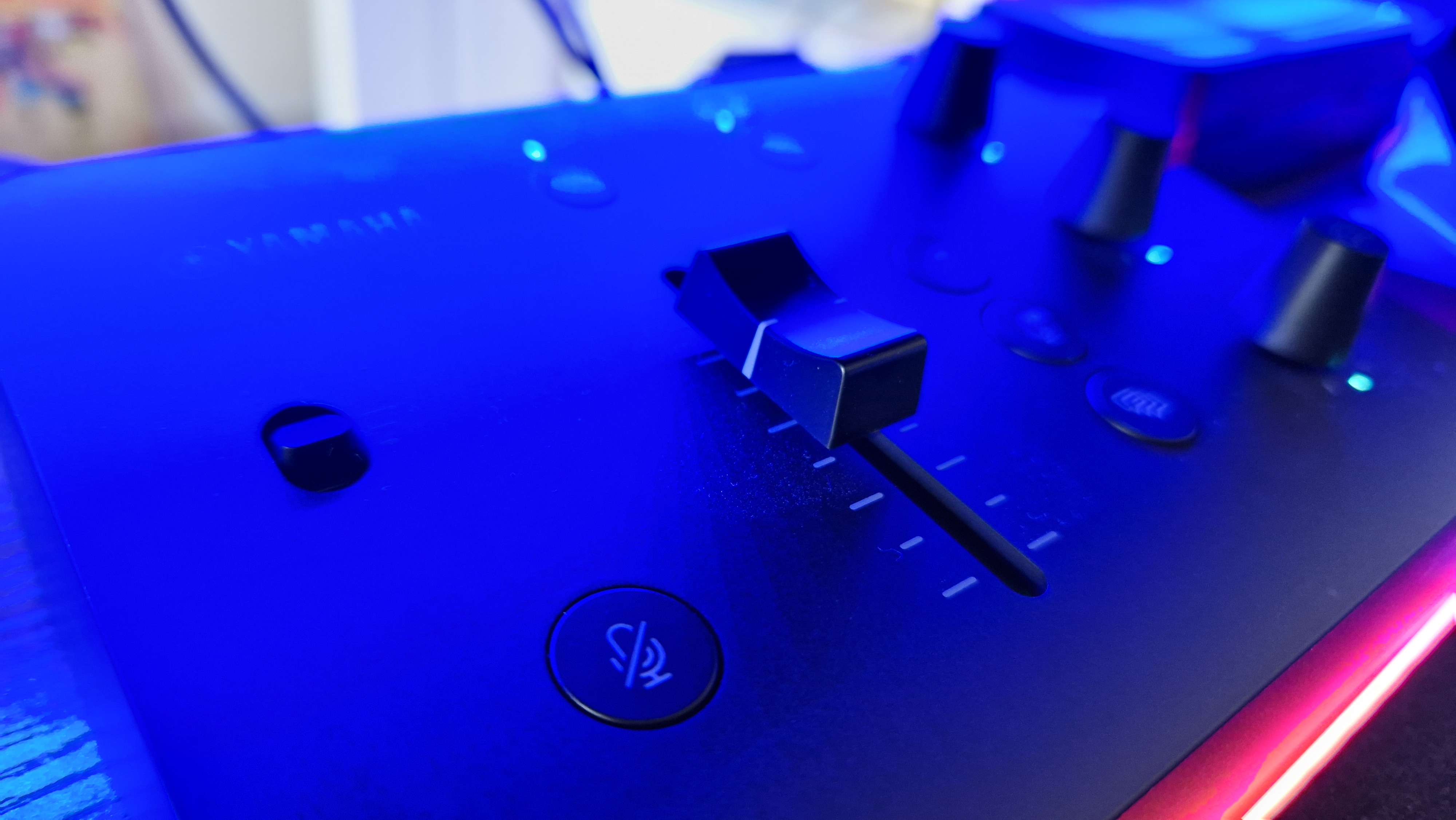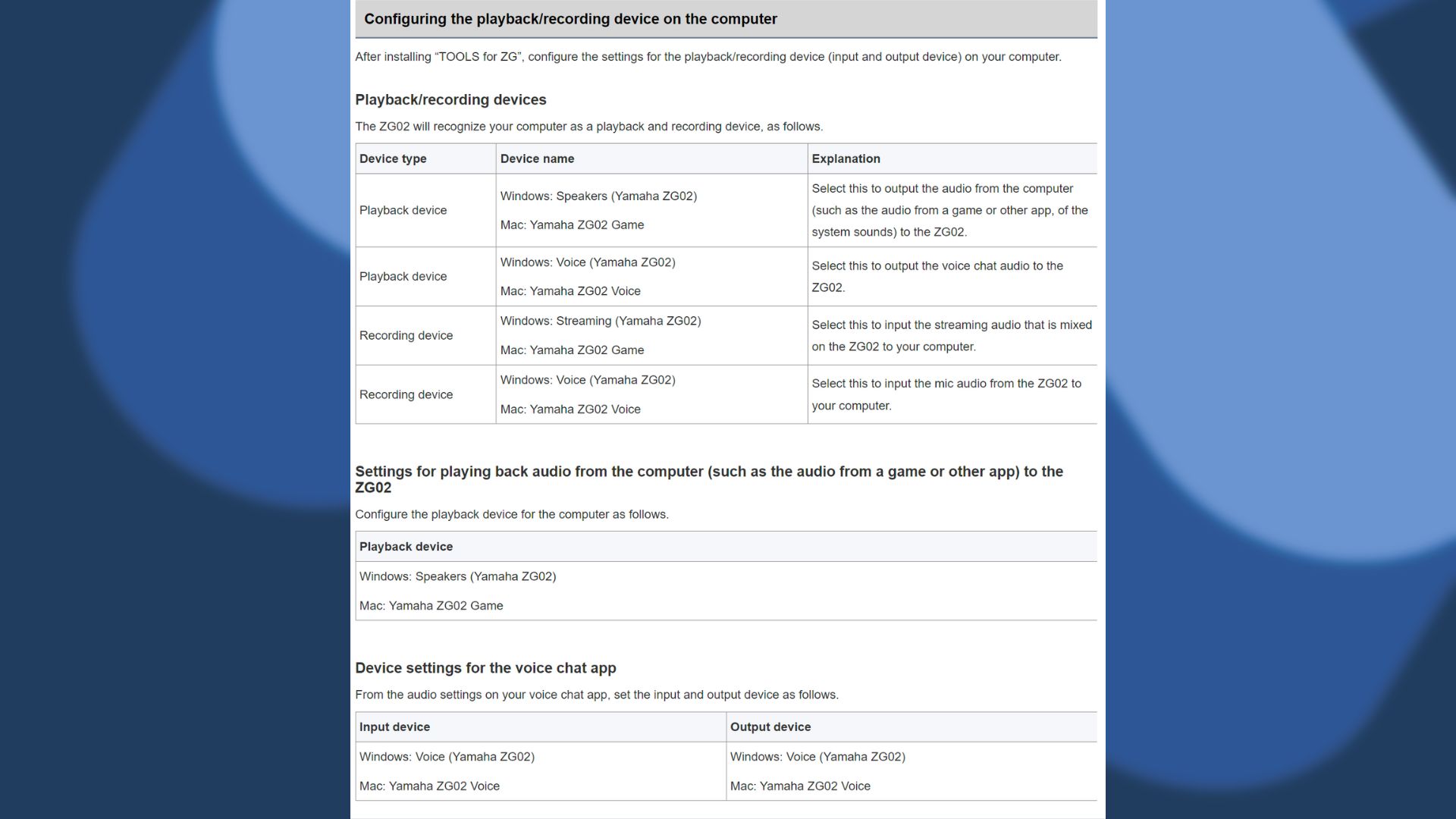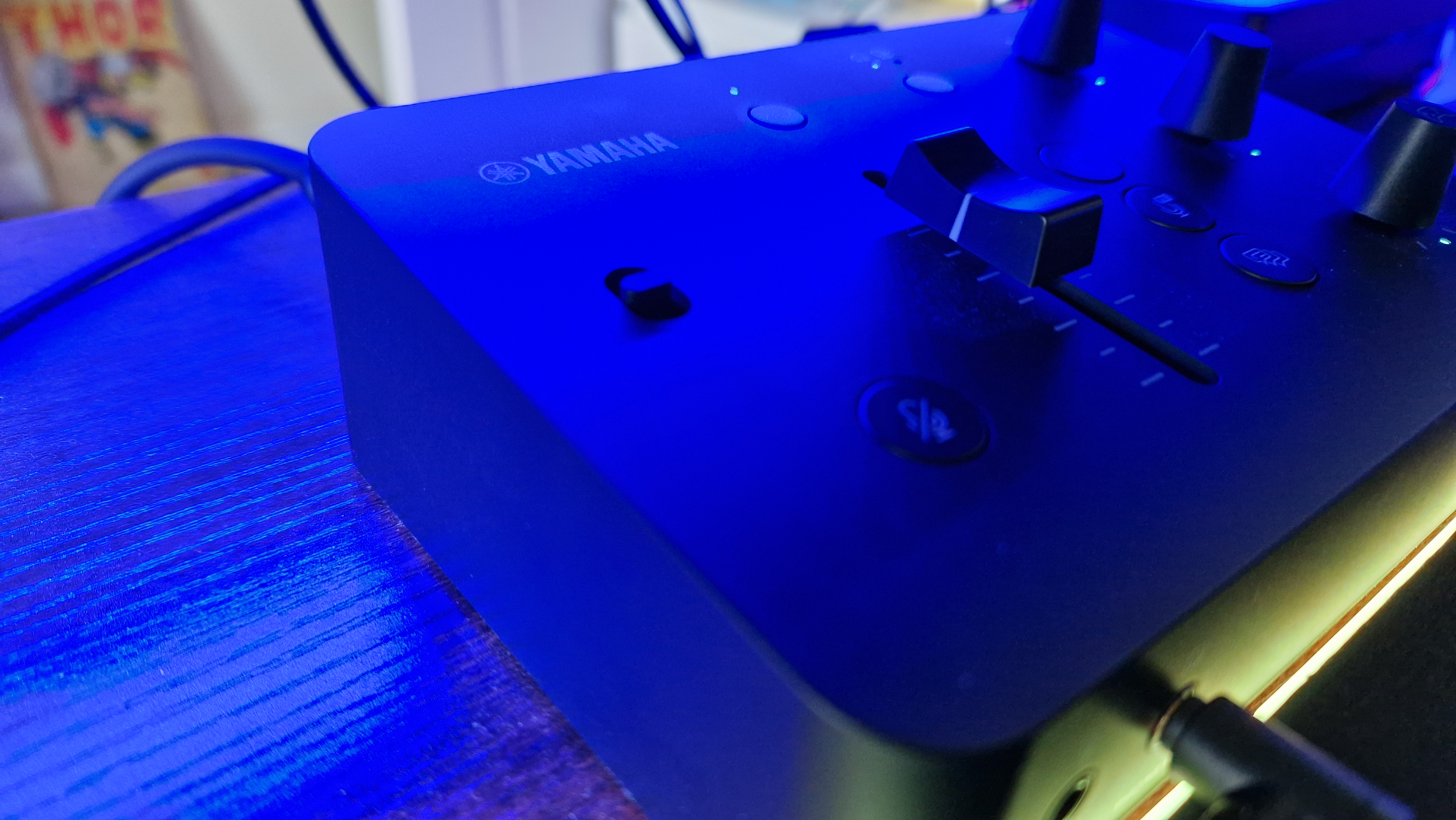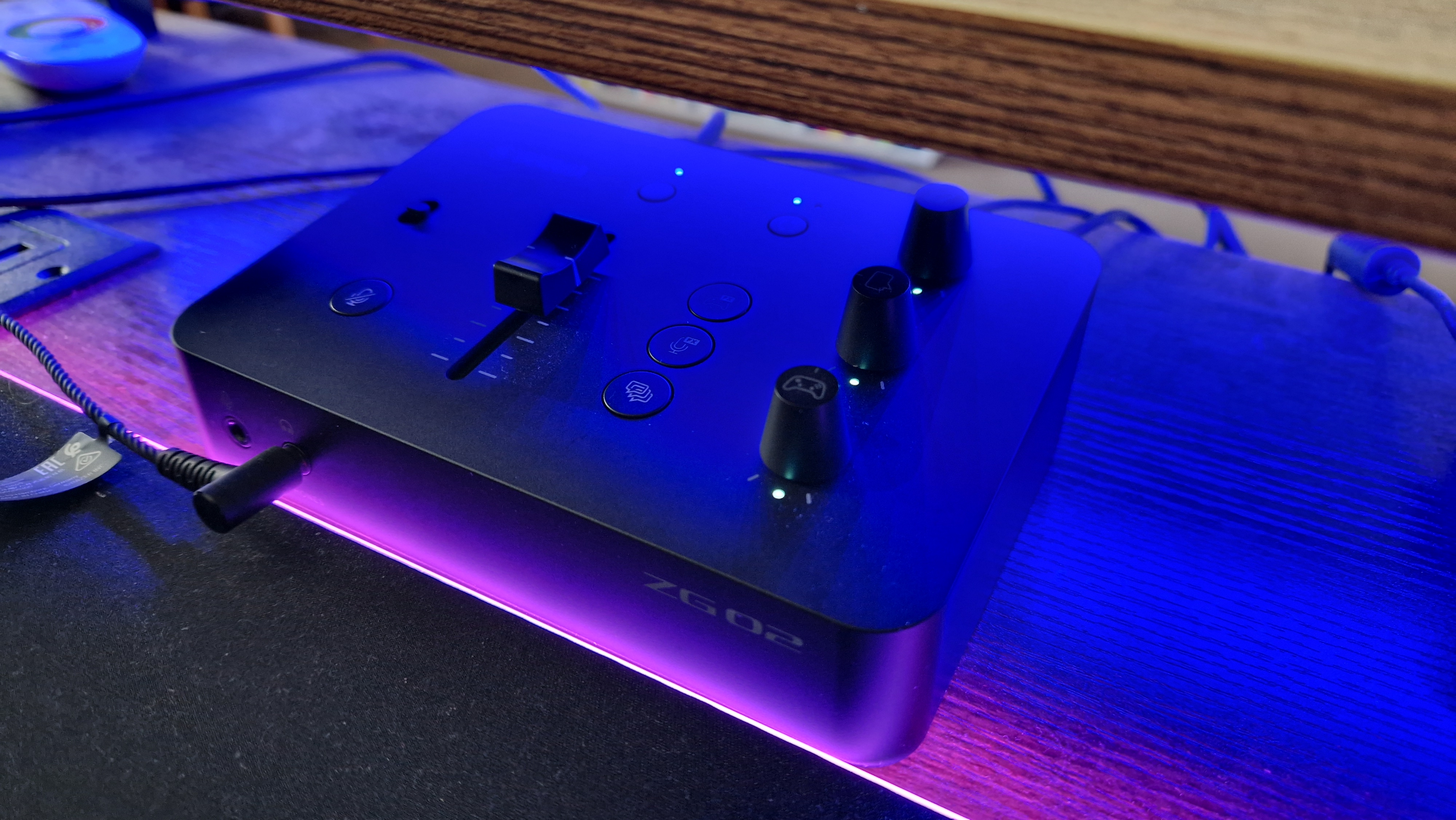GamesRadar+ Verdict
The Yamaha ZG02 does the basics well, but its design choices prevent it from doing much more than that. It works brilliantly for streamers playing on a PS5 since a simple USB-C connection makes it easy to route through all your audio. Annoyingly, the lack of a fourth volume knob in lieu of some silly effects buttons means most creators are going to be found wanting if they want background music in their mix. That and software foibles really hamstrung this device for me.
Pros
- +
Simple, but effective mixer
- +
Great for console streamers thanks to USB-C
- +
Fun audio effects
Cons
- -
The software feels very limited
- -
Setup is a headache
- -
Missing volume knobs
- -
The chassis is plain and feels cheap
- -
Controlling chat/personal mixes could be better
Why you can trust GamesRadar+
The Yamaha ZG02 streaming mixer might surprise you. For starters, who would expect Yamaha to make products for gamers? A piece of streaming hardware might not immediately gel with a lineup of motorcycles, scooters, keyboards, and guitars, but then again, who are we to judge? Not only is the ZG02 made for gaming content creators, but as its name suggests, it's actually the brand's second attempt at entering the streaming market.
Streaming gear for gamers feels like an inexact science, even for well-known brands in the space. As someone who reviews that technology for a living, I can safely say that this subset of hardware feels like a solution to something that just wasn't meant to work. That's true enough for the established companies that design this hardware, so when a brand that's had little to no experience tries to make magic happen, it seldom goes well.
Luckily, the folks at Yamaha Music have decades of experience in the audio department, and their first mixer, the ZG01, seems like it was a promising start. The ZG02 is certainly a strong baseline for content creators looking to take more control of their audio, but I'm afraid to say it's not much more than that. At an MSRP of $199.95 in the US, and available for £170-180 in the UK, it comes up short against the big names in the best streaming controller race.
Design
I'm sorry to say that the design of the Yamaha ZG02 is not an attractive one. In fact, there's not a lot that immediately signals it's a device geared at gamers or live streamers. Its chassis is a black box that's as basic as can be. It's plastic, it's hollow, and its buttons almost echo through it when clicked in. It definitely doesn't feel worth the MSRP, and that's a real shame.

I don't think you need the RodeCaster Duo's LED pads or the BEACN Mix Create's swanky display, but something with a bit more flare would certainly be welcome on a device like this. Not least because streamers need to be able to glance down at it in a dark lighting scenario and know exactly which volume knob does what. I've tested this product for well over two weeks now, and I still have to squint at it to know which buttons are which, and where those buttons even are.
Sadly, the aesthetics aren't the only thing that disappoints in the design department. On the ZG02's face, you'll find three volume knobs on its right-hand side. Then we have three buttons, two for audio effects and one to add echo. This is, by far, one of my biggest frustrations with what Yamaha has made. Four volume knobs simply must be the minimum on a mixer of this price. Mic, game, music, and voice chat are the go-to audio sources for gaming live streamers, and each one really needs its own fader.
The ones Yamaha has put in place are for your mic, voice chat, and game audio, so no matter which way you configure things, you're going to need to double something up if you want background music in the mix. I just don't get the design choice of putting effect buttons where more volume adjusters could be. I don't know any gaming creator that would rather have their game audio distorted instead of having dedicated volume knobs for creator and broadcast mixes. Moreover, I don't know of a streamer who's so hell-bent on using vocal effects that they'd gladly forgo a dedicated way of fading out background music.

The only fader you'll get here is one for the XLR mic's output level, but confusingly, there's a switch to the left of it that controls its gain in three increments. The top volume knob controls how loud your microphone's monitoring level is too, so it's a bit confusing knowing which one to adjust mid-stream. There is a handy mute button since a lot of the best microphones for streaming and gaming in the XLR category miss those out. There's also a phantom power 48V button and one for switching between the headphone and speaker outputs.
Connectivity is one of this mixer's biggest strengths, however. The back IO has an XLR mic in port, a speaker out port, and two USB-C bays. One of these, which is clearly labeled, plugs into your gaming PC and powers the device. The other is an open port for a secondary USB-C connection. If you stream gameplay from a PS5, this will slot in here, but I'd imagine a second gaming PC could potentially work as well. On the front, you'll find a 3.5mm headphone jack and a secondary jack for wired gaming headset mics - which is useful if you don't have a bespoke XLR mic yet.
The unit itself isn't particularly weighty, which means it very easily slides around a desk. If you struggle for space on your worktop, this does have a smaller footprint than its older sibling, the ZG01. In making this device smaller though, Yamaha has actually taken away some convenience instead of adding it. The larger ZG01 has a central volume knob, and a larger, more communicative facial panel overall.
Features

Like any streaming mixer today, there is a bespoke bit of software you'll need to download to reap the ZG02's benefits. I will say now though, this software feels as frustratingly limited as the mixer's design, and I'm not sure which irks me more.
The Yamaha ZG Controller app opens up to a home page that's very stripped back. It only gives you some quick functions that are already on the mixer, as well as an overall output level that feels glaringly lacking from the console's face.
After digging through tabs for controlling the microphone and game sound effects, you'll find a very thin mixer menu. In most gaming-centric audio software, this is front and center and usually features a simple drag-and-drop system for mapping audio sources to volume knobs. Think SteelSeries Sonar or BEACN's software, for reference.
That is so not what you find here. In fact, mapping audio sources to volume knobs is a very confusing process that's done manually in each application you want to use in your live stream, not in the app at all. On the bright side, I love that this is an audio program that doesn't dominate my CPU's processing abilities. On the other hand, this makes it a nightmare to set up and means you'll likely need to readjust your in-app settings between streams.

It doesn't help that the online manuals for this mixer are woefully unhelpful, and closely resemble the look and tone of a maths exam. As you'll see above, the language used in these manuals is so tricky to understand that it seems like its purpose is to confuse you. At the time of writing, there's a series of online video tutorials for the ZG01 mixer, but these aren't much clearer. If I spent close to $200 on this thing, I wouldn't want to work out how to use it from video tutorials dedicated to another device.
The one saving grace of the streaming mixer tab is its linking buttons that distinguish what you hear from what your audience will hear. These can be indicated by small "link" LEDs on the console's facial panel, but they don't prevent it from being really confusing to use. As well, the in-app sliders effectively make the device itself a bit pointless. If people have spent money on a bit of hardware, they shouldn't need to control their personal audio mix in the companion software alone.
Performance

From what I've said so far, you might be thinking that the Yamaha ZG02 is all bad, and that isn't the case. This mixer works. It's certainly usable if you're willing to put the time into figuring it out. It's particularly great if you stream gameplay from a PS5 because a simple USB-C connection means you can route all your audio through your PC. This is no short of brilliant if you've previously relied on one of the best capture cards, or you want to incorporate your PS5 party chat into your stream.
With this handy device, I was able to talk my friends through the PS5 using an XLR microphone I had plugged into the ZG02 and hear my game audio simply by plugging it in. Granted, the easiest way to talk to my friends while streaming was through a Discord call, but that just allowed me to route their voices to a separate volume knob.
The biggest performance hiccups with this device are due to design choices. The lack of a fourth fader and the inclusion of bespoke effect buttons tell me Yamaha doesn't actually understand the market it's trying to service here. Either that or this is a repurposing of an audio interface that was initially designed for a completely different use case.

It's amazing how much you miss the drag-and-drop allowance from more intrusive audio software when that's taken away from a mixer like this. Fortunately, integrating this application's settings into OBS did work after working out what went where. I had no problems getting the ZG02 to talk with Discord and Streamlabs beyond initial setup woes. I do wish the ZG Controller app was more helpful overall though.
Thankfully, I'm testing the Shure SM7dB at the moment, and the XLR capabilities on this mixer harness that microphone's power with ease. Recording VO works well, and the audio effects, as silly and pointless as I think most creators will find them, are good fun. I did enjoy briefly testing out the voice changers when live, and I know my chat probably appreciated them too. The echo button, when I remembered to use it, was good fun as well. Like I said, this mixer isn't all bad - I just think its priorities are askew.
Should you buy the Yamaha ZG02?

If you're a budding Twitch Streamer who plays on a PS5 or Xbox Series X and you're looking to take charge of your audio, the Yamaha ZG02 might just be exactly what you need. As someone who's struggled for years with making the PS5's audio and party chat easy to translate to a live stream, I'm genuinely grateful that something like the ZG02 exists. Beyond opting for a much more expensive RodeCaser Pro 2 or smaller RodeCaster Duo, you're going to struggle to find that sort of functionality.
Unfortunately, beyond the absolute basics of stream mixing, I'm not sure this is the stream controller for many people. If you're reading this review and you're enraged by my critique of the audio effect controls, maybe you're the exact streamer Yamaha was thinking of when it designed this. I just think that, for the money, you can get something a lot more useful from the likes of Elgato, BEACN, Razer, or even TC Helicon with its GoXLR series.
How we tested the Yamaha ZG02
I integrated the Yamaha ZG02 streaming mixer into my setup for a couple of weeks before writing this review. I used its online user guide to set it up, as well as video tutorials made for the ZG01. I plugged a Shure SM7dB into its XLR port and used these both for my main PC input audio, recording voiceover, and broadcasting live on YouTube with them.
I integrated both PC game audio and PS5 audio into the ZG02 and used Streamlabs to help control it during live streaming. I also recorded gameplay footage for an upcoming video project, recording game audio with the ZG02's USB-C connection. I played around with the ZG Controller app to test out audio and mic effects and compared my experience closely to my time with the BEACN Mix Create, and SteelSeries Sonar software.
For more on how we test the latest streaming gear, take a look at our hardware policy.
Looking for more streaming gear? Check out the best webcams, the best ring lights for streaming, and the best green screens.
One of my earliest memories is playing SuperMario64 and wondering why the controller I held had three grips, but I only had two hands. Ever since I've been in love with video games and their technology. After graduating from Edinburgh Napier University with a degree in Journalism, I contributed to the Scottish Games Network and completed an Editorial Internship at Expert Reviews. Over the last decade, I’ve been managing my own YouTube channel about my love of games too. These days, I'm one of the resident hardware nerds at GamesRadar+, and I take the lead on our coverage of gaming PCs, VR, controllers, gaming chairs, and content creation gear. Now, I better stop myself here before I get talking about my favourite games like HUNT: Showdown, Dishonored, and Towerfall Ascension.



